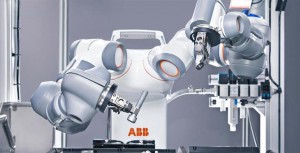How ‘Pushy’ Should Robots Be Allowed to Be?
Posted on October 7, 2014
Filed Under Technology | Leave a Comment
First there was concern over whether robots would replace human workers to such an extent that the economy might collapse under mass unemployment. (At least we think we remember such discussions – Google could probably help refresh us.) Now, though, robotics is an established industrial science, more robots are coming, and the question has become, according to the MIT Technology Review, “Should Industrial Robots Be Able to Hurt Their Human Coworkers?”
Hurt them, us? Picture a vengeful robot on a factory floor who thinks it got too much, or too little, oil, or programming or whatever. Should it be able to zing the engineer it deems responsible with a conk or two? Well, that’s not exactly the question. It’s more like what the U.S. Occupational Safety and Health Administration (OSHA) or the International Standards Organization (ISO) will tolerate in regulations being applied to the use of “collaborative robots” that work along with humans. Sort of like the early (or later) days of nuclear power, we imagine, and the U.S. Nuclear Regulatory Commission.
 A conference was held last week on collaborative robots by the Robotics Industry Association (there was a continental breakfast and, to the best of our knowledge, no robots attended) at which it was noted that, so far, robots have been used mostly by small manufacturers where OSHA assumes they will operate only where humans aren’t nearby. (Talk about a caste system!) “We live a happy life until we reached the big companies,” says Esben Ostergaard, chief technology officer at Universal Robots, a Danish company, “– then we got all these problems about standards.”
A conference was held last week on collaborative robots by the Robotics Industry Association (there was a continental breakfast and, to the best of our knowledge, no robots attended) at which it was noted that, so far, robots have been used mostly by small manufacturers where OSHA assumes they will operate only where humans aren’t nearby. (Talk about a caste system!) “We live a happy life until we reached the big companies,” says Esben Ostergaard, chief technology officer at Universal Robots, a Danish company, “– then we got all these problems about standards.”
Like going, in a way, from the Saxton Nuclear Experimental Corp. to Three Mile Island.
“For collaborative robots to really change manufacturing, and earn significant profits” says the MIT Review, “they must be embraced by large companies, for whom safety certification is crucial.” So, should a robot actually be allowed to hurt a human worker who may be its benchmate. Say, a bruise a day. Well, “that would clearly be intolerable,” said Björn Matthias, a member of the group helping to write the ISO standard, but maybe they could hurt a human sometimes. (Hold it! the NRC would likely say, although bruises and radiation exposure aren’t really comparable.)
So how are collaborative robots and humans really going to be able to get along? How are they going to be able to collaborate big time? The question is complicated by the public’s perception of robots, which equates them with science fiction, the MIT Review notes. So here we have another junction at which humans with their actually limited ability to conceptualize new settings, without enough time and experience, are currently at something of a standoff with their robot partners. But people said airplanes would fall out of the sky, too, notes a manager quoted by MIT. It gets back, once again, to the acceptable level of risk in a new setting. We’re sure we’ll be having safely deployed robot partners sometime in the pretty near future. – Doug Bedell
Comments
Leave a Comment
If you would like to make a comment, please fill out the form below.
Recently
- Presentations With Forethought
- Technical Writing’s Lineage – Surely It’s Deeper than Digital
- At the Holidays, Twitting Amazon
- Successful Cookie Baking – From Mom, an Acknowledged Expert
- Slides for a Tech Writer’s Craft
- Digital or Not, Be Clear
- Being Watchful About Digital Designs…
- When Proposals Don’t Click, Keep Making Them Anyway
- Like a Good Gardener, Help an Enterprise Keep Itself Current
- We’re Leaders All, And Need to Think That Way
Categories
Archives
- January 2017
- December 2016
- November 2016
- October 2016
- September 2016
- August 2016
- July 2016
- June 2016
- May 2016
- April 2016
- March 2016
- February 2016
- January 2016
- December 2015
- November 2015
- October 2015
- September 2015
- August 2015
- July 2015
- June 2015
- May 2015
- April 2015
- March 2015
- February 2015
- January 2015
- December 2014
- November 2014
- October 2014
- March 2014
- February 2014
- January 2014
- December 2013
- November 2013
- October 2013
- September 2013
- August 2013
- July 2013
- June 2013
- May 2013
- April 2013
- March 2013
- February 2013
- January 2013
- December 2012
- November 2012
- October 2012
- September 2012
- August 2012
- July 2012
- June 2012
- May 2012
- April 2012
- March 2012
- February 2012
- January 2012
- December 2011
- November 2011
- October 2011
- September 2011
- August 2011
- July 2011
- June 2011
- May 2011
- April 2011
- March 2011
- February 2011
- January 2011
- December 2010
- November 2010
- October 2010
- September 2010
- August 2010
- July 2010
- June 2010
- May 2010
- April 2010
- March 2010
- February 2010
- January 2010
Blogroll